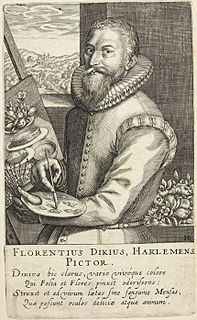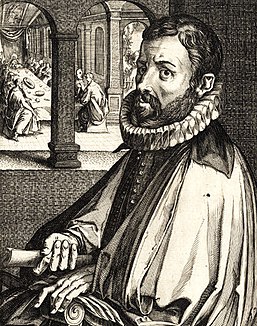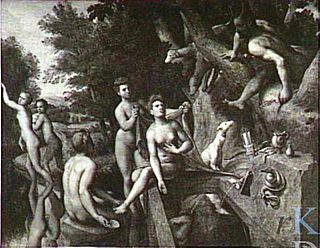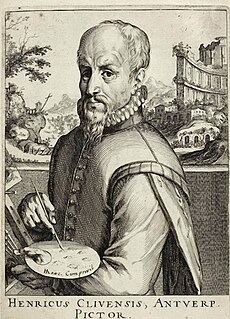
Crispin van den Broeck (1523 – c. 1591) was a Flemish painter. He was born in Mechelen. He came from a family of artists, was probably trained by his father, and was the brother of Willem van den Broeck and Hendrick van den Broeck. He worked as a painter, draftsman and engraver. He was enlisted as a master in the Guild of St. Luke of Antwerp in 1555–6, where he became a citizen in 1559.

Mechelen is a city and municipality in the province of Antwerp, Flanders, Belgium. The municipality comprises the city of Mechelen proper, some quarters at its outskirts, the hamlets of Nekkerspoel (adjacent) and Battel, as well as the villages of Walem, Heffen, Leest, Hombeek, and Muizen. The Dyle flows through the city, hence it is often referred to as the Dijlestad.

Willem van den Broeck (1530–1580) was a Dutch sculptor from the Southern Netherlands.
Hendrick van den Broeck, or Arrigo Fiammingo was a Flemish painter of the late-Renaissance or Mannerist period, active mainly in Italy.
In Antwerp he was a collaborator of Frans Floris with whom he remained until the master’s death in 1570. According to Karel van Mander, Crispin van den Broeck and Frans Pourbus the elder completed an altarpiece for the Grand-Prior of Spain left incomplete at the time of Floris’s death. Van Mander also claimed that Crispin van den Broek was 'a good inventor... clever at large nudes and just as good an architect'. Crispin van den Broek died in Antwerp sometime between 1589 and 6 February 1591.

Frans Floris, Frans Floris the Elder or Frans Floris de Vriendt was a Flemish painter, draughtsman, print artist and tapestry designer. He is mainly known for his history paintings, allegorical scenes and portraits. He played an important role in the movement in Northern Renaissance painting referred to as Romanism. The Romanists had typically travelled to Italy to study the works of leading Italian High Renaissance artists such as Michelangelo, Raphael and their followers. Their art assimilated these Italian influences into the Northern painting tradition.

Karel van Mander (I) or Carel van Mander I was a Flemish painter, poet, art historian and art theoretician, who established himself in the Dutch Republic in the latter part of his life. He is mainly remembered as a biographer of Early Netherlandish painters and Northern Renaissance artists in his Schilder-boeck. As an artist and art theoretician he played a significant role in the spread and development of Northern Mannerism in the Dutch Republic.

Spain, officially the Kingdom of Spain, is a country mostly located in Europe. Its continental European territory is situated on the Iberian Peninsula. Its territory also includes two archipelagoes: the Canary Islands off the coast of Africa, and the Balearic Islands in the Mediterranean Sea. The African enclaves of Ceuta, Melilla, and Peñón de Vélez de la Gomera make Spain the only European country to have a physical border with an African country (Morocco). Several small islands in the Alboran Sea are also part of Spanish territory. The country's mainland is bordered to the south and east by the Mediterranean Sea except for a small land boundary with Gibraltar; to the north and northeast by France, Andorra, and the Bay of Biscay; and to the west and northwest by Portugal and the Atlantic Ocean.
















